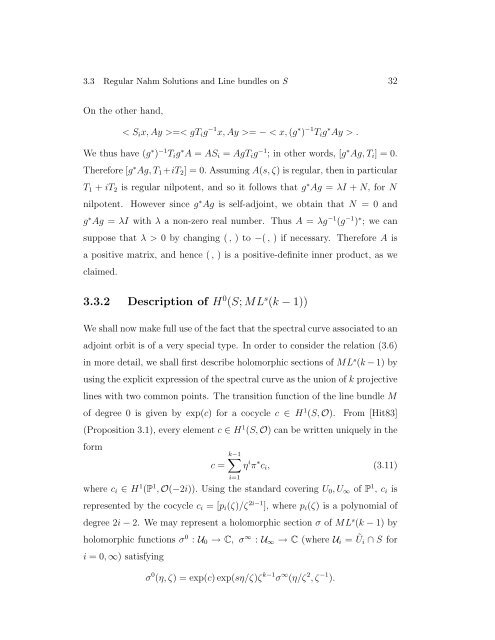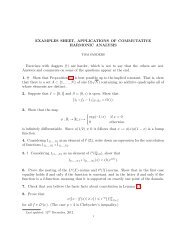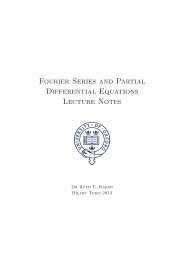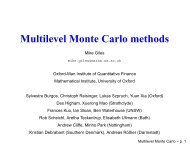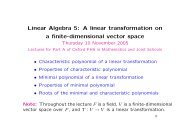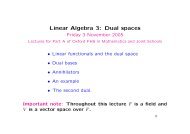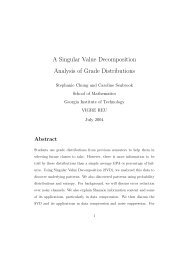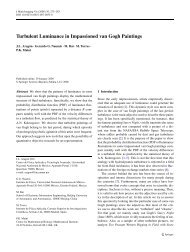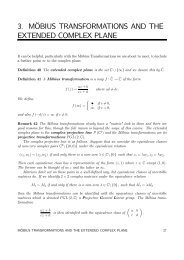Construction of Hyperkähler Metrics for Complex Adjoint Orbits
Construction of Hyperkähler Metrics for Complex Adjoint Orbits
Construction of Hyperkähler Metrics for Complex Adjoint Orbits
Create successful ePaper yourself
Turn your PDF publications into a flip-book with our unique Google optimized e-Paper software.
3.3 Regular Nahm Solutions and Line bundles on S 32<br />
On the other hand,<br />
< Six, Ay >=< gTig −1 x, Ay >= − < x, (g ∗ ) −1 Tig ∗ Ay > .<br />
We thus have (g ∗ ) −1 Tig ∗ A = ASi = AgTig −1 ; in other words, [g ∗ Ag, Ti] = 0.<br />
There<strong>for</strong>e [g ∗ Ag, T1 +iT2] = 0. Assuming A(s, ζ) is regular, then in particular<br />
T1 + iT2 is regular nilpotent, and so it follows that g ∗ Ag = λI + N, <strong>for</strong> N<br />
nilpotent. However since g ∗ Ag is self-adjoint, we obtain that N = 0 and<br />
g ∗ Ag = λI with λ a non-zero real number. Thus A = λg −1 (g −1 ) ∗ ; we can<br />
suppose that λ > 0 by changing ( , ) to −( , ) if necessary. There<strong>for</strong>e A is<br />
a positive matrix, and hence ( , ) is a positive-definite inner product, as we<br />
claimed.<br />
3.3.2 Description <strong>of</strong> H 0 (S; ML s (k − 1))<br />
We shall now make full use <strong>of</strong> the fact that the spectral curve associated to an<br />
adjoint orbit is <strong>of</strong> a very special type. In order to consider the relation (3.6)<br />
in more detail, we shall first describe holomorphic sections <strong>of</strong> ML s (k − 1) by<br />
using the explicit expression <strong>of</strong> the spectral curve as the union <strong>of</strong> k projective<br />
lines with two common points. The transition function <strong>of</strong> the line bundle M<br />
<strong>of</strong> degree 0 is given by exp(c) <strong>for</strong> a cocycle c ∈ H 1 (S, O). From [Hit83]<br />
(Proposition 3.1), every element c ∈ H 1 (S, O) can be written uniquely in the<br />
<strong>for</strong>m<br />
k−1<br />
c =<br />
i=1<br />
η i π ∗ ci, (3.11)<br />
where ci ∈ H 1 (P 1 , O(−2i)). Using the standard covering U0, U∞ <strong>of</strong> P 1 , ci is<br />
represented by the cocycle ci = [pi(ζ)/ζ 2i−1 ], where pi(ζ) is a polynomial <strong>of</strong><br />
degree 2i − 2. We may represent a holomorphic section σ <strong>of</strong> ML s (k − 1) by<br />
holomorphic functions σ 0 : U0 → C, σ ∞ : U∞ → C (where Ui = Ũi ∩ S <strong>for</strong><br />
i = 0, ∞) satisfying<br />
σ 0 (η, ζ) = exp(c) exp(sη/ζ)ζ k−1 σ ∞ (η/ζ 2 , ζ −1 ).


